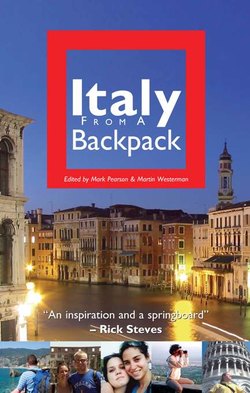Читать книгу Italy from a Backpack - Mark Pearson - Страница 6
На сайте Литреса книга снята с продажи.
ОглавлениеIntroduction
ask any traveler to Europe’s “Boot” (lo Stivale), “Why Italy?” and he or she responds with the almost inarticulate bemusement of someone in the infatuation phase of a love affair. Italy is irresistible. We return again and again for the cuisines, the wines, the festivals, the unique regions and attitudes—all rooted in the very soil under the traveler’s feet.
If you live in the West or speak any Romance or Germanic language, you can trace roots back to here, in the Roman and Greek Empires, even if you’re not Italian. Your diet probably depends in part—or entirely—on Italian cuisine: pizza, spaghetti and meatballs with parmesan and crusty garlic bread, minestrone, mineral water, Caesar salad (invented in Florida, actually, but since it’s named after Caesar…) and gelato. You may have salivated over Ferraris and Lamborghinis; perhaps you appreciate Italian style and the composure with which Italians approach life. They may promptly finish their midday espressos standing at narrow, high-top tables, but Italians will take three or four hours to enjoy a dinner that doesn’t begin until at least 8 p.m. Ah, simple pleasures.
Italy From a Backpack is full of pleasures, too—stories of young people whose discoveries make delightful, even surprising reading. My co-editor, Mark Pearson, hatched this idea for books about youthful European travels when he returned home from studying art history in Rome and backpacking around Europe. He found that people weren’t so interested in viewing his 2,200 digital photos. Instead, they wanted to hear great stories.
At the time, few, if any, books of stories were written by and for backpackers—even though, every year, nearly two million Americans ages 18 to 29, and hundreds of thousands of Brits, Canadians and Australians, head for Europe to travel, study and work. Most carry their worldly possessions on their backs, travel on shoestring budgets, and decide daily where they’ll go and what they’ll do. Often, these free-ranging nomads experience marvels that elude people who carry suitcases and make reservations.
Mark put out an invitation on the Web for stories, and the rest, as they say, is history. The series includes Europe From a Backpack, Spain From a Backpack and, now, Italy From a Backpack.
So, join us as we find Reine Bouton, fresh from Metairie, Louisiana, attempting to imitate Italian female attitude in “High Heels From Hell,” and Bill Fink hitting a snag as he tries to catch a morning bus for Rome in “Hostage of the Hostile Hostel.” We find as many reasons to travel here as there are backpackers. They come for history (“Not As Seen on TV”), family (“Finding Signora Bacca”), study (“Layering”), romance (“The Way of Love”), adventure (“Shirts Off for Bill and Ted”), art (“Art Appreciation”) and exploration (“Ligurian Daydream”). Generally, travelers head first for the three must-see cities, Rome, Florence, and Venice, and branch out from there. One section in this book is devoted entirely to Cinque Terre, because backpackers are raving about this string of five coastal villages on the Italian Riviera, featured in Rick Steves’ guidebooks.
While guidebooks are useful, telling us where to go and what to do, stories about what people experienced are powerful. The better they’re told, the more we feel as if we are participating in them ourselves. Accompanying Heather Strickland in “Not As Seen on TV,” we are told that no guidebook could have revealed Pompeii to her the way discovering it on her own did. She writes, “The Discovery Channel couldn’t come close to (describing) the overwhelming feeling of walking through streets where once-vivacious people died running for their lives. The slideshows and pictures could never explain this place.”
At a time when we’re bombarded by the Internet, social-networking sites, all means of media, overwhelming life details, and bizarrely focused news that transfixes us in horrified fascination, it’s lovely to break away and transport ourselves, however briefly, to other places, where good things happen, we gain wisdom, and everything turns out all right.
The people we meet in these stories live in a state of peace. They are generous, curious and welcoming, and we can happily interact with them through the magic of our travelers’ stories. These stories provide little oases in a crowded and fast-paced world. For us co-editors, they re-awaken urges to travel every time we read them.
We not only get the thrill of living vicariously through someone else’s travels—enjoying fond memories if we have traveled, and getting inspired if we haven’t—but we also learn, through the hindsight these travelers provide, wisdom about what to do and what not to do when we actually get there. The stories serve as tantalizing tastes of what awaits us, as escapes from our daily lives.
In “Becoming History,” Shannalee T’Koy writes that at one time in her life, she thought her world was the only world, but travel to distant places has changed that. “Finding myself in the minority in a sea of human beings who speak languages foreign to me, who live in a million ways differently from me, lives completely unconnected to mine, I no longer feel so important or big. But maybe by connecting myself to timeless places like Rome, and joining the invisible register of visitors who have stood where I stand, I enlarge myself. Maybe by being part of a massive whole, I’m not so insignificant after all, and as my perspective grows, so does my world.”
That is the gift we offer in this new collection. Enjoy.
Martin Westerman
www.europebackpack.com
